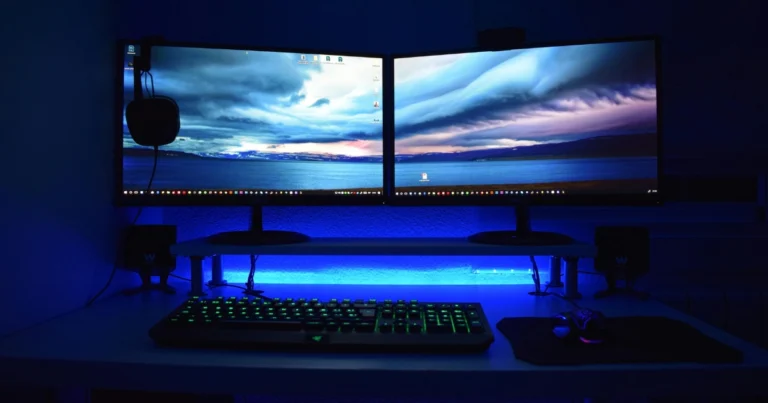Table of Contents
Gaming performance gets a huge boost with a 280Hz monitor. It changes how you see games in fast-paced digital worlds. These high-refresh-rate screens make games smoother and more responsive. This gives gamers a big advantage in quick games.
Monitors like ASUS TUF’s 280Hz models offer clear visuals that regular screens can’t. They show frames fast, cutting down on motion blur. This means sharper images during intense game moments.
For pro gamers and esports fans, every millisecond counts. A 280Hz monitor updates the screen almost instantly. This lets you react faster and move more precisely in games.
Key Takeaways
- Reduced motion blur during high-speed gaming
- Enhanced visual responsiveness
- Superior performance for competitive gaming
- Ultra-smooth frame rendering
- Microsecond advantage in esports environments
Understanding Monitor Refresh Rates and Their Impact on Gaming
When you explore gaming displays, knowing about refresh rates is key. A 280 hz monitor is at the forefront of tech, offering unmatched smoothness and quickness.
Modern gaming needs precision and clear visuals. Refresh rates are vital for your gaming success. They show how often your screen updates, affecting your game’s look and your edge in competition.
The Science Behind Screen Refresh Rates
Refresh rates are measured in hertz (Hz), showing how often your screen updates per second. A 2k 165hz monitor is good, but a 280 hz monitor boosts visual smoothness even more:
- Standard monitors usually run at 60 Hz
- Gaming monitors range from 144 Hz to 280 Hz
- Higher refresh rates cut down on image stuttering
How Higher Refresh Rates Reduce Motion Blur
Fast scenes can blur on lower refresh rate screens. But with a 280 hz monitor, you get:
- Crisp, clear images during quick movements
- Less visual artifacts
- Better tracking of fast objects
Input Lag vs. Response Time
Many gamers mix up input lag and response time. Response time is how fast pixels change colors. Input lag is the delay between your action and the screen display.
A top-notch 280 hz monitor cuts down on both. This gives competitive gamers a big advantage in fast games.
Benefits of a 280 Hz Monitor for Competitive Gaming
Competitive gamers know every millisecond is crucial. A 280 hz monitor offers a visual advantage that can change your gaming. It updates the screen more often, giving players an edge in fast games.
The main benefits of a 280 hz monitor are:
- Less motion blur when moving fast in games
- Smoothened tracking of quick targets
- Less input lag for quicker responses
- Better clarity in competitive shooters
Gamers with an ASUS TUF 1440p monitor at 280 Hz refresh rate see top-notch responsiveness. The mix of high resolution and refresh rate makes for an immersive experience. It combines visual quality with a competitive edge.
Precision is key in esports. Whether it’s first-person shooters, racing games, or multiplayer, a 280 hz monitor helps you react quicker. The smooth motion also cuts down eye strain and keeps performance steady during long gaming sessions.
“Speed isn’t just about hardware—it’s about giving yourself every possible competitive advantage.” – Professional eSports Analyst.
For serious gamers, a high-refresh-rate display like the 280 hz monitor is essential. It’s not just a luxury anymore—it’s a must-have for a competitive edge.
Comparing 280Hz to Other Refresh Rates (165Hz, 240Hz)
Choosing the right monitor refresh rate can greatly improve your gaming. Whether you’re looking at a 280 hz monitor or a 2k 165hz monitor, knowing the differences is key.
Gamers often ask about the visual differences between refresh rates. Each increase in hertz makes motion smoother and reduces screen tearing. This leads to a more immersive gaming experience.
Visual Performance Across Refresh Rates
The differences in refresh rates become clearer as you go higher:
- 165Hz: Smooth gameplay with minimal motion blur
- 240Hz: Less input lag and clearer motion
- 280Hz: Top-notch responsiveness for competitive gaming
Price-to-Performance Breakdown
Refresh RateAverage CostGaming Performance
165Hz $250-$350 Good for casual gamers
240Hz $350-$450 Excellent for competitive play
280Hz $450-$600 Premium performance for eSports
Gaming Experience Insights
A 280 hz monitor gives you a big competitive edge. Milliseconds matter in high-stakes games. These monitors offer fast visual feedback, which can make all the difference.
While a 2k 165hz monitor is great for many gamers, those wanting the best will love 280Hz. It offers sharp, fast responsiveness.
Hardware Requirements for Running a 280Hz Display
To get the most out of a 280 hz monitor, you need more than just the display. Your gaming setup must have specific parts to handle the fast refresh rates of modern monitors like the Asus 31.5 curved gaming monitor.
Here are the key hardware parts you’ll need:
- High-performance Graphics Card (GPU)
- Powerful Processor (CPU)
- Adequate RAM
- Compatible Connection Ports
Your graphics card is key for smooth gaming. NVIDIA RTX 3070 and AMD Radeon RX 6800 series are top picks for fast frame rates that match the 280 hz monitor.
ComponentMinimum RequirementRecommended Specification
GPU NVIDIA RTX 3060 NVIDIA RTX 3080 or AMD RX 6800 XT
CPU Intel i5-10600K Intel i7-11700K or AMD Ryzen 7 5800X
RAM 16GB DDR4 32GB DDR4 3600MHz
Connection DisplayPort 1.4 DisplayPort 1.4 or HDMI 2.1
Choose hardware that can handle high frame rates. The Asus 31.5 curved gaming monitor needs a strong system for top-notch visuals.
Popular 280Hz Gaming Monitors in the Market
Choosing the right 280 hz monitor can change your gaming world. New display techs give gamers top-notch visuals and fast action. It’s key for both pro esports players and serious gamers to know what’s out there.
Top Features to Consider
When looking at 280 hz monitors, some features really stand out:
- Panel Type: IPS and VA panels offer great color
- Resolution: 1440p options like Asus TUF 1440p our top picks
- Adaptive sync techs (G-Sync/FreeSync)
- Connectivity options (DisplayPort, HDMI 2.1)
- Low input lag
Price Range and Value Proposition
280 Hz gaming monitors cost between $350 and $700. The Asus TUF series is a great value, offering top performance at a good price. Even on a budget, you can find monitors that meet your needs.
Brand Comparison
BrandAverage PriceKey Strengths
ASUS TUF $399-$549 Robust build, excellent color accuracy
Acer Predator $499-$699 Advanced overdrive tech
MSI Optix $429-$579 Sleek design, good price
Each brand has its own strengths in the 280 hz monitor market. Your best choice depends on what you like, your budget, and your gaming needs.
Professional Gaming and eSports Applications
Professional gamers know how important a 280 hz monitor is in competitive gaming. These high-refresh-rate displays are key for top eSports athletes. They help improve reaction time and visual clarity, giving a competitive edge in fast tournaments.
Top eSports teams like Team Liquid and Cloud9 use 280 hz monitors for training and matches. These monitors offer smooth visuals and less eye strain. They help players track fast in-game movements with great precision.
Major gaming tournaments now see the value of high-refresh-rate monitors. Game developers are making games better for these monitors. This shows a future where visual performance is as important as player skill.
The 280 hz monitor is more than display tech—it’s a competitive tool. It helps bridge the gap between human reaction and visual perception. Professional gamers see these monitors as vital for staying ahead in gaming.
FAQ
What makes a 280Hz monitor better for gaming compared to lower refresh rates?
A 280Hz monitor offers smoother visuals, less motion blur, and less lag. It updates the screen more often. This is great for fast games, especially first-person shooters and esports.
Are 280Hz monitors compatible with all gaming systems?
Not all systems can handle a 280Hz monitor. You need a strong GPU and CPU. Most top graphics cards from NVIDIA and AMD work well, needing a DisplayPort.
How does a 280Hz monitor differ from a 165Hz monitor?
A 280Hz monitor refreshes the screen 280 times a second. A 165Hz monitor does it 165 times. This means smoother motion, less screen tearing, and quicker response times for gamers.
What should I look for when buying a 280Hz gaming monitor?
Look at the panel type (IPS or TN), resolution (like 1440p), and screen size. Also, check color accuracy and features like G-Sync or FreeSync. Brands like ASUS TUF have great options.
Are 280Hz monitors worth the extra cost?
Yes, for serious gamers and esports fans. The better visuals and less lag are big advantages. But, casual gamers might not see as much difference.
Can I use a 280Hz monitor for tasks other than gaming?
Yes, 280Hz monitors are good for many tasks. They’re great for graphic design, video editing, and general computer use. They offer smooth and clear visuals.
What connection type do I need for a 280Hz monitor?
You’ll need a DisplayPort 1.4 or HDMI 2.1 for a 280Hz monitor. Make sure your graphics card and cable support these to enjoy the monitor’s full benefits.




